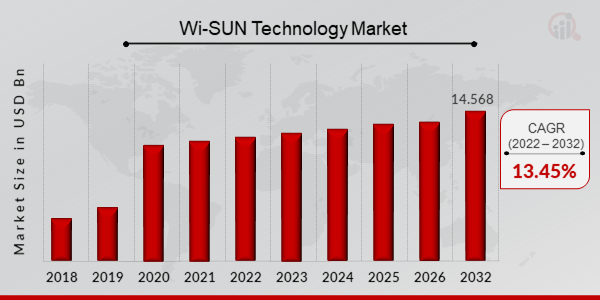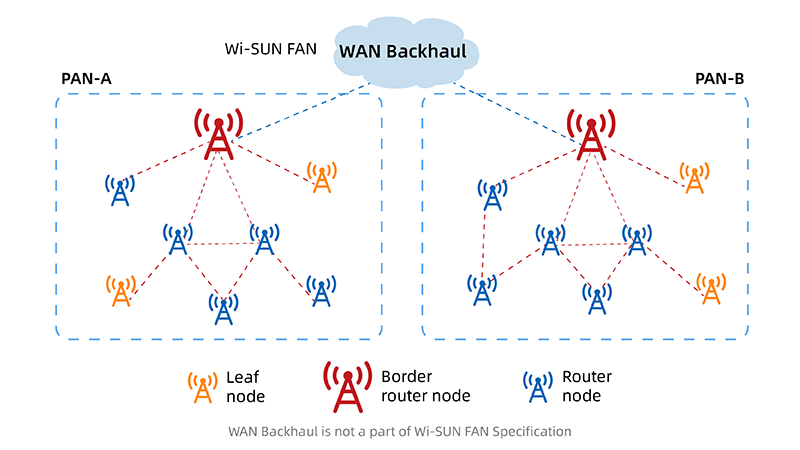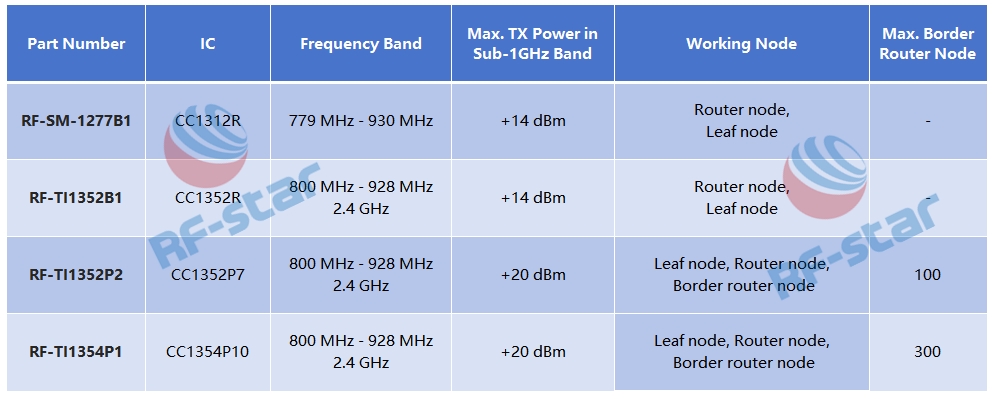The digital revolution has brought the Internet of Things (IoT) into the fabric of our daily lives. Wi-SUN technology, celebrated for its robust performance and versatile applications, has become a favored option for large-scale IoT implementations. This article explores the Wi-SUN technology market, its main benefits, use cases and applications, and RF-star’s implementation of Wi-SUN.
Recent Wi-SUN Technology Market Research Report by Business Research Insight and Market Research Future indicate that the global Wi-SUN technology market, valued at USD 319.27 million in 2022, is predicted to reach USD 14.568 billion at a whopping 13.45% CAGR between 2024-2032. This surge is fueled by ongoing proliferation of smart meters, sensors, and IoT devices, as well as the accelerated digital transformation spurred by the COVID-19 pandemic. Notably, North America stands out as a region with significant adoption of Wi-SUN technology.

Figure1:Wi-SUN Technology Market Size, 2023-2032 (USD Billion)
Source: https://www.marketresearchfuture.com/reports/wi-sun-technology-market-8695
Wi-SUN, or Wireless Smart Ubiquitous Network, is a wireless communication network based on the IEEE 802.15.4 standard. It delivers a high-performance, low-power, long-range, robust anti-interference, high data throughput, and highly secure wireless communication solution.
As a mesh network, it facilitates long-distance communication and high-data transmission between IoT devices through frequency-hopping and self-configuration technology. The network also features self-healing capability.
Wi-SUN supports two primary operational profiles: Home Area Network (HAN) and the Field Area Network (FAN):

Figure 2 Wi-SUN network topology
Wi-SUN technology is finding its place in various global applications:
Wi-SUN's long-distance transmission, scalability, bidirectional communication, and low power consumption have led to its deployment in many cities for smart meters and streetlights. For example, a Smart Cities Living Lab in Hyderabad, India, utilizes Wi-SUN mesh network technology to manage city assets efficiently.
Wi-SUN technology supports large-scale outdoor IoT networks, including AMI metering and distribution automation, offering smart streetlight solutions for cities. In London, Wi-SUN mesh networks power streetlights, reducing maintenance costs and energy consumption while enhancing flexibility for aesthetic lighting and public safety.
In smart cities, Wi-SUN technology enables real-time monitoring and management of electricity usage, optimizing energy distribution and reducing consumption.
Wi-SUN networks allow for real-time monitoring of solar panel operations through intelligent monitoring systems, ensuring maximum power generation efficiency while minimizing environmental impact.
In smart grids, Wi-SUN technology is used to deploy smart low-voltage cabinets, dynamically adjusting power supply and optimizing power distribution to enhance grid reliability and flexibility.
Wi-SUN technology is also applied in the industrial and manufacturing sectors, providing non-proprietary solutions that make deployment more scalable, flexible, and secure.
As a global manufacturer of wireless modules, RF-star can supply a range of Wi-SUN modules based on TI CC1312 and CC1352 series chips.
As shown below, the parameters of the Wi-SUN modules are listed:

Figure 3 RF-star’s Wi-SUN Modules
In August, RF-star is set to launch a new Wi-SUN module based on the TI CC1354P10 SoC. This module is expected to be a multiprotocol and dual-band 800 MHz - 928 MHz and 2.4 GHz wireless module with 1024 kB Flash and 288 kB RAM. Notably, the RF-TI1354P1 module can operate as a border router, extending up to 300 nodes. This will provide robust support for large-scale, distributed IoT complex applications. Stay tuned!
Wi-SUN's unique mesh network architecture, combined with its low latency, high data throughput, low power consumption, ease of deployment and scalability, high security, interoperability, and long-range transmission capabilities, makes it an ideal solution for wide-area large-scale IoT applications. As the market for Wi-SUN continues to expand, its applications in smart cities, smart energy, and industrial IoT are growing, showcasing its potential to enhance connectivity efficiency, reduce costs, and improve user experience. With manufacturers like RF-star leading the development of high-performance Wi-SUN modules, the future of large-scale distributed IoT deployments looks promising.